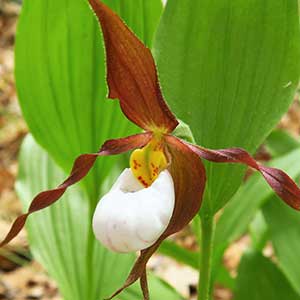Cypripedium montanum
Cypripedium yatabeanum
mountain lady slipper, mountain lady's-slipper, white lady's-slipper
spotted lady's slipper
4–6, inserted toward base or scattered along stem, alternate, erect, ascending, or spreading;
blade suborbiculate or broadly ovate to elliptic-lanceolate, 3.3–17 × 2.5–9.5 cm.
2(–3, very rarely), on middle half of stem, alternate to subopposite, wide-spreading;
blade elliptic-lanceolate to lance-ovate or ovate-suborbiculate, 6–12 × 3–7 cm.
1–3;
sepals greenish, suffused, often heavily, with reddish brown or madder, or rarely clear green;
dorsal sepal lance-acuminate to elliptic-lance-acuminate, 33–60 × 8–16 mm;
lateral sepals connate;
synsepal 30–60 × 6–18 mm;
petals spreading-deflexed, same color as sepals, spirally twisted, linear to linear-lanceolate, 36–77 × 3–5 mm;
lip white, rarely suffused with magenta, obovoid or oblance-ovoid to oblance-fusiform, 19–33 mm;
orifice basal, 13–22 mm;
staminode lanceoloid to broadly ovoid or ellipsoid-ovoid.
solitary;
sepals white to yellowish or greenish with brownish or tan markings;
dorsal sepal obovate to ovate, 15–23 × 9–18 mm;
petals spreading, same color as sepals, acuminate-subpandurate to acuminate-pandurate (constricted near middle), flat, 10–14 × 5–8 mm, much shorter than lip, margins undulate-revolute;
lip similarly colored, oblance-fusiform to oblance-ovoid, 17–32 mm;
orifice basal, 10–22 mm;
staminode oblong-quadrangular to broadly ellipsoid or ovoid.
= 20.
Cypripedium montanum
Cypripedium yatabeanum
Plants of Cypripedium montanum grown in exposed, relatively sunny situations have the ascending leaves inserted along the basal portion of the stem and the flowers displayed well above the leaves. In shadier, especially sheltered sites, the spreading leaves may be more evenly scattered along the stem. In this species the apical margin of the orifice of the lip is usually acute, in common with C. candidum, and in contrast to the usually obtuse margin in C. parviflorum; this difference can aid determination of discolored herbarium specimens. Hybrids of C. montanum and C. parviflorum have been designated C. ×columbianum Sheviak. See 11. C. parviflorum for a general discussion of hybridization and variation within and between related species.
(Discussion copyrighted by Flora of North America; reprinted with permission.)
Cypripedium yatabeanum is known from only a few collections in North America and hence the description may be too restrictive. From the much more common and widespread C. guttatum, it is distinguished by flowers with pale brown markings and a markedly narrow aspect, with comparatively narrow lip, short, often pandurate petals constricted toward the middle, and narrower dorsal sepals commonly broadest toward the apex. Asiatic plants are sometimes considerably larger than those of C. guttatum, and robust Japanese plants sometimes bear three leaves. Plants typical of Asiatic C. yatabeanum occur on some of the Aleutian Islands, while on other islands, plants with brownish markings appear morphologically intermediate between these taxa, or more typical of C. guttatum. Elsewhere in southern Alaska, populations of typical C. guttatum support some plants with pale brownish pink markings. This situation has suggested to some that these taxa were only infraspecifically distinct. The distribution of the intermediate plants, however, suggests that geographically limited introgression during an earlier, more extensive presence of C. yatabeanum is an appropriate interpretation. Evident introgressants have been named C. ×alaskanum P. M. Brown, and most reports and illustrations of C. yatabeanum in Alaska are in fact based on them.
(Discussion copyrighted by Flora of North America; reprinted with permission.)
- Local floras:
BC,
CA,
OR,
WA
- Local Web sites:
CalFlora,
CalPhotos,
Flora NW,
PNW Herbaria,
Turner Photog.
WildflowerSearch
iNaturalist (observations)
USDA Plants Database
- LBJ Wildflower Center
- SEINet
- Plants of the World Online
- Encyclopedia of Life
- Wikipedia
- Google Image Search


